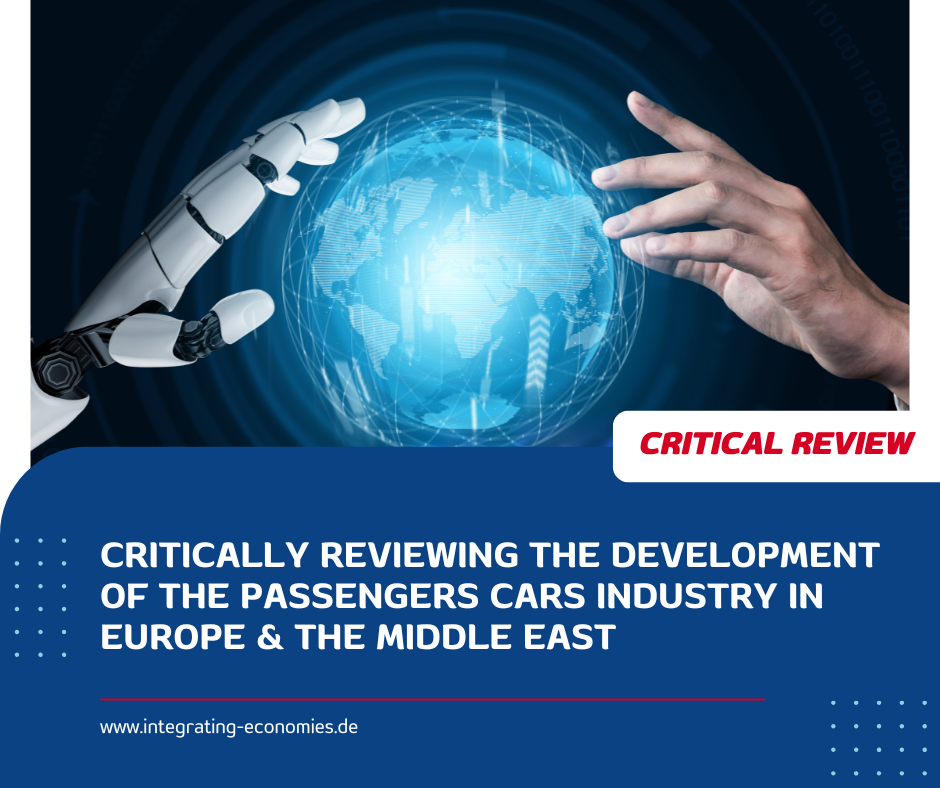
Car Passengers Production; Europe and Middle East Review
Comparing the Automotive Industry for Car Manufacturing in the Middle East and Europe
Introduction
The automotive industry serves as a vital pillar of modern economies, driving innovation, employment, and global trade. Europe has long been a leader in car manufacturing, known for its precision engineering, iconic brands, and advanced technologies. Conversely, the Middle East, a region historically dominated by oil and gas exports, is transitioning into a more diversified economy. This includes significant investments in automotive manufacturing as part of broader economic reforms. This blog undertakes a detailed comparison of these two regions, focusing on production capabilities, labor market dynamics, technology adoption, and policy landscapes. Through statistical insights and visual aids, we explore the current state and future potential of the automotive industries in Europe and the Middle East.
Europe: A Mature Automotive Hub
Europe’s automotive industry is globally recognized for its maturity and innovation. Iconic brands such as Volkswagen, BMW, Mercedes-Benz, Renault, and Fiat have shaped the global automotive landscape, setting benchmarks for quality and performance. The continent’s automotive sector contributes significantly to its GDP, employing millions of individuals across the value chain. In 2022, Europe produced approximately 16 million passenger cars, accounting for 21% of global production. Germany, often referred to as the engine of Europe, leads the region in car manufacturing, contributing nearly 30% of the total output. Other key players include France, Italy, and Spain, each with a strong presence in both domestic and export markets.
Europe’s emphasis on sustainability and technological advancement is evident in its leadership in electric vehicle (EV) production and adoption. Norway, for instance, achieved a groundbreaking EV adoption rate of 71% in 2022, far surpassing global averages. Germany, France, and the UK are also investing heavily in EV infrastructure and production facilities, signaling a shift towards greener mobility.

Figure 1: Car Production in 2022 - Europe vs. Middle East.
Middle East: An Emerging Player
The Middle East, historically reliant on oil exports, is emerging as a key player in automotive manufacturing. As part of their economic diversification strategies, countries like Saudi Arabia and the UAE are making significant investments in local car production. Saudi Arabia’s Vision 2030 plan includes ambitious targets for developing an automotive ecosystem, focusing on both conventional and electric vehicles. The region’s first major EV manufacturer, Ceer, is a joint venture aimed at producing electric vehicles tailored to regional needs.
n 2022, the Middle East produced approximately 0.5 million cars, accounting for 0.7% of global production. While this figure may seem modest compared to Europe, it represents a significant step forward for a region new to large-scale automotive manufacturing. The UAE has also emerged as a regional hub for assembly plants, attracting partnerships with international brands. These developments highlight the Middle East’s potential to become a competitive player in the global automotive market.
Production Capacity and Infrastructure
Europe’s production capacity is underpinned by a well-established supply chain and decades of experience in car manufacturing. The region boasts highly advanced factories equipped with cutting-edge robotics and automation technologies, enabling high-volume and high-quality production. By contrast, the Middle East is building its production capacity from the ground up, focusing on modern facilities and partnerships with established global manufacturers. For instance, Saudi Arabia’s joint venture with Lucid Motors aims to produce 150,000 EVs annually by 2028
Workforce and Labor Dynamics
Europe’s automotive workforce is among the most skilled globally, benefiting from strong vocational training programs and collaborations between industry and academia. However, high labor costs remain a challenge, prompting some manufacturers to relocate production to lower-cost regions.
The Middle East, in contrast, offers a cost-effective labor market supported by a mix of expatriate and local workers. Governments are investing in education and training to enhance the skills of the local workforce, aiming to reduce reliance on imported talent. This strategy is expected to bolster the region’s competitiveness in the coming years.
Technological Advancements
Europe is a global leader in automotive innovation, particularly in the areas of electric vehicles (EVs), autonomous driving, and connectivity. Major automakers are investing heavily in research and development to stay ahead of the curve. The Middle East, while still in the early stages of technological adoption, is making significant strides. The focus on EVs as part of Saudi Arabia’s Vision 2030 is a testament to the region’s commitment to sustainable innovation.

Figure 2: EV Adoption Rates in Europe (2022).
Policy and Economic Frameworks
The European Union’s stringent regulations on emissions and safety have been a driving force behind the region’s transition to sustainable practices. These policies have pushed automakers to adopt cleaner technologies and invest in EV production. The Middle East is also introducing policies to support the growth of its automotive sector, including tax incentives for foreign investors and subsidies for green technologies. As these frameworks mature, they are likely to attract more global players to the region.
Conclusion
Europe and the Middle East represent two distinct paradigms in the automotive industry. Europe’s legacy of innovation and high-volume production contrasts with the Middle East’s emerging role as a cost-effective and forward-looking player. As the Middle East continues to invest in its automotive industry, particularly in EVs, it is poised to become a significant competitor on the global stage. Both regions will undoubtedly play crucial roles in shaping the future of mobility.




